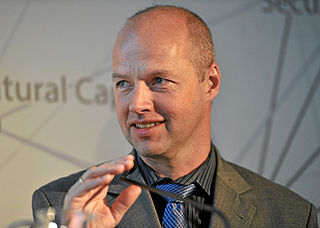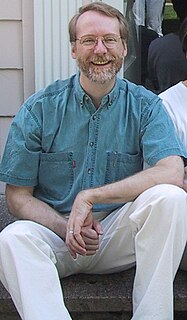Related Research Articles
In artificial intelligence, genetic programming (GP) is a technique of evolving programs, starting from a population of unfit programs, fit for a particular task by applying operations analogous to natural genetic processes to the population of programs. It is essentially a heuristic search technique often described as 'hill climbing', i.e. searching for an optimal or at least suitable program among the space of all programs.
A stored-program computer is a computer that stores program instructions in electronically or optically accessible memory. This contrasts with systems that stored the program instructions with plugboards or similar mechanisms.
Usability engineering is a field that is concerned generally with human-computer interaction and specifically with devising human-computer interfaces that have high usability or user friendliness. It provides structured methods for achieving efficiency and elegance in interface design.

In computer science, evolutionary computation is a family of algorithms for global optimization inspired by biological evolution, and the subfield of artificial intelligence and soft computing studying these algorithms. In technical terms, they are a family of population-based trial and error problem solvers with a metaheuristic or stochastic optimization character.
A genetic operator is an operator used in genetic algorithms to guide the algorithm towards a solution to a given problem. There are three main types of operators, which must work in conjunction with one another in order for the algorithm to be successful. Genetic operators are used to create and maintain genetic diversity, combine existing solutions into new solutions (crossover) and select between solutions (selection). In his book discussing the use of genetic programming for the optimization of complex problems, computer scientist John Koza has also identified an 'inversion' or 'permutation' operator; however, the effectiveness of this operator has never been conclusively demonstrated and this operator is rarely discussed.
In genetic algorithms and evolutionary computation, crossover, also called recombination, is a genetic operator used to combine the genetic information of two parents to generate new offspring. It is one way to stochastically generate new solutions from an existing population, and analogous to the crossover that happens during sexual reproduction in biology. Solutions can also be generated by cloning an existing solution, which is analogous to asexual reproduction. Newly generated solutions are typically mutated before being added to the population.

Frank Thomson "Tom" Leighton is the CEO of Akamai Technologies, the company he co-founded with Daniel Lewin in 1998. Akamai has become the top content delivery provider in the 21st century with the arrival of dedicated techs. As one of the world's preeminent authorities on algorithms for network applications and cybersecurity, Dr. Leighton discovered a solution to freeing up web congestion using applied mathematics and distributed computing.
Nancy Ann Lynch is a mathematician, a theorist, and a professor at the Massachusetts Institute of Technology. She is the NEC Professor of Software Science and Engineering in the EECS department and heads the "Theory of Distributed Systems" research group at MIT's Computer Science and Artificial Intelligence Laboratory.

Sebastian Thrun is an entrepreneur, educator, and computer scientist from Germany. He is CEO of Kitty Hawk Corporation, and chairman and co-founder of Udacity. Before that, he was a Google VP and Fellow, a Professor of Computer Science at Stanford University, and before that at Carnegie Mellon University. At Google, he founded Google X and Google's self-driving car team. He is also an Adjunct Professor at Stanford University and at Georgia Tech.
Thomas Albert "Tom" DeFanti is an American computer graphics researcher and pioneer. His work has ranged from early computer animation, to scientific visualization, virtual reality, and grid computing. He is a distinguished professor of Computer Science at the University of Illinois at Chicago, and a research scientist at the California Institute for Telecommunications and Information Technology (Calit2).

The IBM Time Sharing System TSS/360 is a discontinued early time-sharing operating system designed exclusively for a special model of the System/360 line of mainframes, the Model 67. Made available on a trial basis to a limited set of customers in 1967, it was never officially released as a supported product by IBM. TSS pioneered a number of novel features, some of which later appeared in more popular systems such as MVS. TSS was migrated to System/370 and 303x systems, but despite its many advances and novel capabilities, TSS failed to meet expectations and was eventually canceled. TSS/370 was used as the basis for a port of UNIX to the IBM mainframe. TSS/360 also inspired the development of the TSS-8 operating system.

Michael Lee Scott is a professor of computer science at the University of Rochester in Rochester, New York.

Nils John Nilsson was an American computer scientist. He was one of the founding researchers in the discipline of artificial intelligence. He was the first Kumagai Professor of Engineering in computer science at Stanford University from 1991 until his retirement. He is particularly known for his contributions to search, planning, knowledge representation, and robotics.
David G. Messerschmitt is an engineer and professor emeritus at the University of California, Berkeley in the Department of Electrical Engineering and Computer Sciences in the UC Berkeley College of Engineering. He retired from UC Berkeley in 2005. At present he is conducting research at Berkeley, is a visiting professor in the Software Business Laboratory at the Helsinki University of Technology, and is doing research on interstellar communications at the SETI Institute. Messerschmitt also serves on the Advisory Council of METI.
Katherine Isbister is a game and human computer interaction researcher and designer, currently a professor in computational media at the University of California, Santa Cruz. Until June 2015, she was an associate professor at New York University, with a joint appointment in computer science and in the Game Center at the Tisch School of the Arts. At NYU, she was founding research director of the Game Innovation Lab. Isbister's research and design contributions center on how to create more compelling emotional and social qualities in games and other digital experiences. She has innovated in the areas of character/avatar/agent design and in researching and evaluating the user experience. Her book, Better Game Characters by Design: A Psychological Approach, was nominated in 2006 for a Game Developer Magazine Frontline award. She is also co-editor of a book which outlines the state of the art in user research practices in studying games, titled Game Usability: Advice from the Experts for Advancing the Player Experience.

Evolutionary biology, in particular the understanding of how organisms evolve through natural selection, is an area of science with many practical applications. Creationists often claim that the theory of evolution lacks any practical applications; however, this claim has been refuted by scientists.
Inductive programming (IP) is a special area of automatic programming, covering research from artificial intelligence and programming, which addresses learning of typically declarative and often recursive programs from incomplete specifications, such as input/output examples or constraints.
Stanford DASH was a cache coherent multiprocessor developed in the late 1980s by a group led by Anoop Gupta, John L. Hennessy, Mark Horowitz, and Monica S. Lam at Stanford University. It was based on adding a pair of directory boards designed at Stanford to up to 16 SGI IRIS 4D Power Series machines and then cabling the systems in a mesh topology using a Stanford-modified version of the Torus Routing Chip. The boards designed at Stanford implemented a directory-based cache coherence protocol allowing Stanford DASH to support distributed shared memory for up to 64 processors. Stanford DASH was also notable for both supporting and helping to formalize weak memory consistency models, including release consistency. Because Stanford DASH was the first operational machine to include scalable cache coherence, it influenced subsequent computer science research as well as the commercially available SGI Origin 2000. Stanford DASH is included in the 25th anniversary retrospective of selected papers from the International Symposium on Computer Architecture and several computer science books, has been simulated by the University of Edinburgh, and is used as a case study in contemporary computer science classes.

Una-May O'Reilly is an American computer scientist and leader of the AnyScale Learning For All (ALFA) programme at the MIT Computer Science and Artificial Intelligence Laboratory.
References
- ↑ Kennedy, Pagan (2013-07-05). "Who Made That Scratch-Off Lottery Ticket?". The New York Times. ISSN 0362-4331 . Retrieved 2018-03-02.
- ↑ Keats, Jonathon (2006-04-19). "John Koza Has Built an Invention Machine". Popular Science.
- ↑ Yi, Matthew (2006-07-24). "Stanford professor stumps for electoral alternative". San Francisco Chronicle .
- ↑ "Out-of-state group seeks to oust Peter Courtney, president of Oregon Senate". OregonLive.com. Retrieved 2018-03-02.